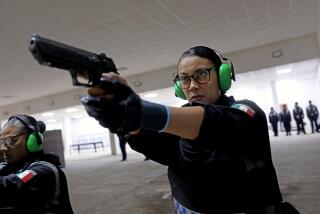Brazil Tries to Rein In Its Police
- Share via
RIO DE JANEIRO — The children of Vigario Geral, a dusty urban battlefield enclosed by train tracks, collect bullets the way other children collect marbles or seashells.
After gunfights between police and gangsters, the children of the favela, or slum, retrieve spent bullets by the fistful, the bucketful--a thousand bullets a month.
The children exchange the bullets for candy at the House of Peace, a community center established in a favela house where police are accused of massacring a family of evangelical Christians three years ago. Amid the slaughter, two ski-masked gunmen argued about the fate of five children, sparing them after one gunman threatened to kill the other if he shot them. Three dozen officers will go on trial in October on charges of killing a total of 21 people that night.
“I don’t understand how the police can act so coldly, they don’t seem like people,” said Vera dos Santos, 33, who lost her parents and brothers and sisters. “I don’t believe in the justice system. I am preparing for a disappointment.”
Vigario Geral remains a symbol of Brazil’s struggle against human rights abuse. President Fernando Henrique Cardoso recently launched a historic human rights program aimed largely at stopping police violence, which sometimes resembles an undeclared war. On paper, the program is a model for Latin America.
But the reforms face difficulties both on the street and in the political arena. An illustration: Cardoso gave Brazil’s first human rights award to a young sociologist from Vigario Geral who turned the house of death into the House of Peace. But the sociologist fled to the United States this year because he received death threats--allegedly from rogue police.
“Brazil is a nation where the political, economic and social structures permit a great deal of violence,” said Jose Gregori, the No. 2 official in the Justice Ministry and the president’s point man on human rights. “So human rights questions are discussed in a climate of controversy. . . . But the existence of the program is an advance.”
Fear of crime is the fundamental obstacle.
Violence is the leading cause of death among youths in this country, according to a recent study. Brazil records 17 murders per 100,000 people, compared with 11 per 100,000 in the United States. Many Brazilians applaud police for administering street justice.
After a wave of sadistic robberies and murders in affluent homes and nightspots in Sao Paulo this month, survivors had hostile words for the city’s bishop, a critic of police misconduct. Their anger reflects a belief that the words “human rights” are code for protecting the enemy.
This war-like mentality has a swashbuckling champion: Gen. Nilton Cerquiera, the public security chief of the state of Rio de Janeiro. Cerquiera commanded a feared military anti-subversion unit during the military dictatorship that ended in 1985. He came out of retirement last year to lead Rio’s counterattack on lawlessness.
In comments to journalists last week, Cerquiera, 66, a bespectacled white-haired warrior, defended his policy of what he described as salary raises for bravery. He scorned critics who blame such “Wild West bonuses” for an eightfold surge in police shootings over the past year.
Rio’s crime rate has abated this year, with murders dropping to 1990 levels. Cerquiera said the police are winning the battle despite a “Maginot Line” of human rights activists defending criminals. “A bandit has to be treated like a bandit, no matter what the human rights groups say,” Cerquiera declared.
Although federal officials argue that both crime and police brutality can be controlled, Cardoso’s proposals face opposition in Congress. Cardoso, a distinguished sociologist, has a long record of activism on human rights. He has written books on social problems such as poverty and race relations, and his opposition to the dictatorship forced him into exile at one time.
After being elected in 1994, Cardoso recruited a leading scholar on violence, Paulo Sergio Pinheiro of the University of Sao Paulo, to design a long list of judicial and social reforms. “What has been decisive is the personal commitment of the president,” Pinheiro said.
Civilian Justice
A landmark law passed this month shifts trials in questionable police killings from military tribunals, which are considered lenient, to civilian courts. A new program will protect witnesses such as the youth who survived the 1993 murders of sleeping street children in front of Candelaria Cathedral in Rio; after testifying against the police, he was wounded in an ambush and went into hiding in Switzerland.
Most important, human rights violations will become a federal crime prosecuted by special units comparable to the U.S. Justice Department’s civil rights division. Until now, Brazilian law has impeded federal intervention even in cases such as the massacre in April of 19 landless peasants in a confrontation with police in the Amazonian state of Para, where landowners allegedly control police and judges. Legislation to expand federal jurisdiction is pending in Congress.
Nonetheless, the Cardoso administration must avoid seeming biased against the police, said Gregori, the Justice Ministry official. “Security in Brazil was enforced violently by the military regime. So activists never had much sympathy for questions of law enforcement.”
The dictatorship exacerbated abuses rooted in profound economic inequality. Today, the “military police” who patrol the streets in Brazil are run by state governments. But the forces retain the personnel, attitudes and tactics of military rule, critics say.
“They have their own institutional logic,” said James Cavallaro, the director of Human Rights Watch/Americas in Brazil. “And they are not under control of the civilian government.”
Murder and Torture
Watchdog groups document cases of on-duty murder and torture and off-duty “extermination squads.” Police in Rio and Sao Paulo kill in the line of duty 300 to 400 people yearly in each city, at least 10 times more than in U.S. cities, according to Human Rights Watch. In Los Angeles last year, police killed 17 suspects; in Sao Paulo, one officer, Gilson Lopez, has taken part in at least 44 fatal shootings during his career, according to Human Rights Watch.
The causes of the violence are endemic to Latin America: poor police training and pay, an ineffectual justice system that breeds graft and impunity. And in the seething, sprawling slums where the asphalt ends, Brazilian police must fight militarized drug mafias who rule with grenade launchers and a flair for community relations.
Brazil has more than 3,400 favelas, which are often founded by squatters in precarious canyons and remote suburbs and lack basic services. In Rio, 1.8 million people, about a third of the city’s population, live in favelas.
Vigario Geral, a neighborhood of 10,000 in the industrial outskirts of Rio, is a classic example. The only direct entrance is a metal footbridge over the railroad tracks. Inside the slum, flat dirt lanes run among a mix of solid two-story houses and wooden shacks slumped along a fetid lagoon.
The atmosphere on a warm Wednesday is friendly. But the drug underworld flourishes on the main street: A muscular gangster on a bicycle rides back and forth on mobile sentry duty, a pistol and a cellular telephone in his belt. Two women totter by, snorting cocaine with rolled-up bills.
Traffickers affiliated with the Red Command, a citywide mafia, function as a de facto government. They suppress common crime by meting out brutal punishment to rapists and burglars, and shell out cash--in a neighboring favela, gangsters commissioned a water slide for the children.
“Here, you can sleep with the doors and the windows open,” said Valmir Vale, 27, a local artist. “The traffickers have a good-neighbor policy. Because the government has neglected the favelas, they end up playing the role of the state.”
The danger flares when traffickers fight each other or the police, who venture into the favela only in wary foot platoons, girded for combat. The shootouts--often several per week--scar the walls with bullet holes, around which youths paint connect-the-dot flowers.
‘Desperate Souls’
The bullets collected by the children are turned over to Vale, a former factory welder. He solders the bullets together into raw and compelling sculptures, the detritus of death transformed into protest art. His latest sculpture will be unveiled Thursday, the third anniversary of the massacre. It depicts a cowering man, woman and child and is titled “Desperate Souls.”
Vale is a product of a community that was reborn after the massacre, whose victims were working people with no apparent connection to the underworld.
Enraged by the murders of four officers in the favela, a police death squad wearing hooded, Ninja-type masks went on a rampage with grenades and automatic weapons, authorities say. The raiders killed seven patrons of a small bar and then stormed across the favela’s main street into the home of the Dos Santos family, apparently bent on eliminating witnesses, survivors say.
Three years later, Vera dos Santos can still hear the interminable gunfire that echoed down the block to the house where she lived. Two of the surviving children, her nephews, now live with her; one still sees apparitions of his slain mother.
The cheerful, dignified Dos Santos, an avid gospel singer, has become a social activist. She speaks out against police abuse. She works as an administrator at the House of Peace, which offers reading and math classes and a library and computer center donated by foreign corporations.
“Out of a bad thing came many good things,” Dos Santos said. “I lost my blood family, but I gained a bigger family. More people in the community here are more united.”
Pride of Vigario Geral
The driving force behind the House of Peace was sociologist Caio Ferraz, 27, the pride of Vigario Geral. He is one of the favela’s few university graduates, a relentless, diminutive man whose brother died at the hands of police in the neighborhood years ago.
As a result of the attention brought by the massacre, Ferraz, Vale and a few others struck up a friendship with a group of writers and intellectuals active in Viva Rio, a civic group formed to counter violence and class tension.
“I think we learned more from them than they did from us,” said Manoel Ribeiro, an architect who helped Ferraz design the community center.
Ferraz won international acclaim. His work caught the eye of Cardoso, who was speaking out on the human rights issue. That did not prevent Ferraz from being stalked and threatened after he criticized a police raid in the favela last year. The government relocated him and his family to a federal police barracks in another city.
But Ferraz complained that he was treated like a prisoner. He moved to Boston with the help of a Brazilian politician and U.S. diplomats, and now studies at MIT.
Skeptics in Vigario Geral and elsewhere say Ferraz’s experience is harsh proof of the distance between official rhetoric and reality. Justice Ministry official Gregori disputes the notion that the government could not protect Ferraz, but acknowledges that overcoming impunity is a Sisyphean task.
Vigario Geral shows the dimensions of the problem and the potential for solutions. Brazil is a nation where extremes of hope and despair coexist.
“We can’t look back, because we might give up,” said Dos Santos, her face serene and determined. “We always have to look forward, with our heads held high.”
And then, abruptly, she wept.
More to Read
Sign up for Essential California
The most important California stories and recommendations in your inbox every morning.
You may occasionally receive promotional content from the Los Angeles Times.










